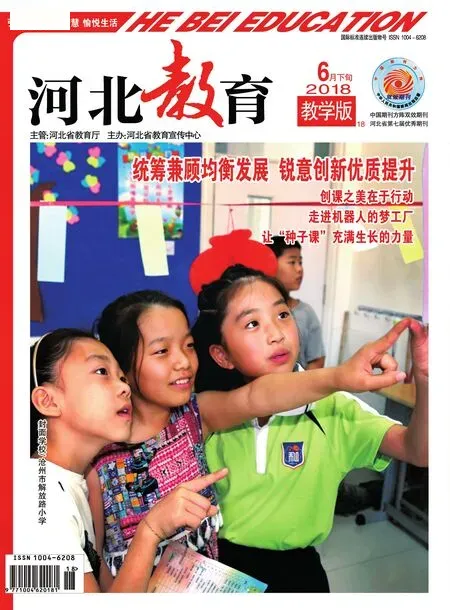小学英语综合板块教学的有效性探究
○宋桃娟
现有的小学英语教材大多都是围绕某一主题编排单元,而每个单元都是分板块编写的,除了以Story time为核心的语篇板块外,其余板块都以不同的形式对该单元的主要学习内容进行强化、拓展、归纳和整理。这些板块形式多样、信息丰富,具有灵活开放的特点,内容各有侧重,但很少有内在联系,作为教材不可或缺的组成部分,有其独特的功能和作用。本文以Asking the way中Sound time、Culture time和 Cartoon time等几个板块的教学为例,阐述教师如何通过一条教学主线整合各板块的教学。
一、紧扣教学主线,活化语音板块
Asking the way在Sound time板块中以一首附有插图的Rhyme呈现了字母组合sh的发音/∫/,旨在引导学生在诵读Rhyme的过程中体会字母组合sh的发音/∫/。Rhyme的内容与插图,与本单元话题Asking the way没有直接的联系,教师可以根据单元话题Asking the way确立一条与之相关的教学主线Bobby asks the way,使这一语音板块成为本单元教学的一个组成部分。教学过程如下:
1.听Rhyme,理解Rhyme大意。
T:Bobby doesn’t know the way to the shoe shop.Because he wants to meet his new e-friend Sharon.He asks Sharon the way to the shoe shop.Look,the girl in the picture is Sharon.Do you want to know something about her? Let’s listen to the Rhyme about Sharon.
2.读Rhyme,体会字母组合sh的读音/∫/。
T:Boys and girls,let’s try to read the Rhyme together.And pay attention to the sound of the words in red letters.
3.着眼单词,提炼字母组合sh的读音/∫/。
引导学生学习Rhyme中含有红色字母的单词:Sharon、shoe、shop、she、shiny,并注意字母组合sh在这些单词中的发音/∫/。
4.复现旧知,积累语音知识。
T:Can you find out more words with the sound/∫/.学生陆续说出了如下含有读音/∫/的单词:sheep、show、ship、shirt...
5.游戏活动,巩固字母组合sh的读音/∫/及s的发音/s/。
教师通过PPT呈现一个大盒子,里面有很多鞋子图片(鞋子上印有含有字母sh或s的单词),之后让学生将不同的鞋子图片分别放入两个不同的小盒子里,从而帮助Sharon选择正确的鞋子图片。在Bobby asks the way教学主线的辅助下,学生认识了Bobby的新网友Sharon,并帮助她选择了正确的鞋子,原本枯燥乏味的语音教学变得鲜活生动起来。
二、紧扣教学主线,丰富阅读板块
很多版本的小学英语教材在Cartoon time板块编排了一些富有童趣的卡通故事,旨在巩固本单元所学的语言知识和提高学生的阅读能力。例如,Asking the way单元在Cartoon time板块中呈现了卡通故事,内容如下图所示。


教师可以紧扣在Sound time板块中确立的Bobby asks the way的主线继续教学,从而自然进入本单元卡通故事阅读板块的教学活动。
1.看动画,整体感知故事。
每个单元在Cartoon time安排的卡通故事,相较于Story time更有趣、更浅显易懂,新的知识点也较少,因此借助动画中的插图,学生能轻松地从整体上感知故事。
T:From Sound time,we know Sharon is Bobby’s new e-friend.She likes shiny shoes.What does Bobby like?
S1:He likes football.
S2:Perhaps he likes watching TV...
T:Yes.And he likes watching films.He wants to see the film this afternoon.Now he is asking Tina the way to the cinema.How does he get to the cinema?Do you want to know?
Ss:Yes.
T:Let’s watch the cartoon and try to find out the way they choose to get to City Cinema.
教师引导学生通过Bobby问电影院的情景走进卡通故事,并找出故事中Bobby去电影院的方式。
2.读故事,根据上下文理解词义。
T:Bobby and Tina want to go to City Cinema.Look at the picture.They’re looking for the way to the cinema.Do you have any questions?
S1:How do they get to the cinema?
S2:Can they see the film?Why?
......
T:Wonderful.How many ways do they choose to get to City Cinema?How do they get there at last?Please read the story and the pictures.Try to guess the meanings of the following words:stop,full,too many,over.
为了检测学生对上述新词的理解,在学生自主阅读故事的基础上,结合故事中的插图,分别设计了如下填空练习,让学生选择新单词填空。
基于插图2设计填空题:Bobby and Tina wait for the bus at the(stop).The bus is(full),so they can’t get on the bus.
基于插图3设计填空题:There are(too many)cars in the street.
基于插图4设计填空题:They get to the cinema by metro,but the film is(over).
......
在读完故事后,让学生讨论他们为什么坐了出租车后又换乘了地铁,由此拓展Traffic jam,并让学生讨论如何阻止交通堵塞的状况出现,在尽可能多地给学生创造语言输出机会的同时倡导学生绿色出行,保护环境,使学生在这个过程中体验语言与生活的联系,真正做到学以致用。
3.表演故事,在体验中提升语言能力。
T:Do you like the story?
Ss:Yes.
T:Now let’s act out the story in groups.One plays Bobby.One plays Tina.And all of us play the narrators.
在学生理解故事的基础上,适时引导学生根据故事大意开展表演活动,促进他们在深入体验故事的过程中提升语言运用能力。
三、紧扣教学主线,拓展文化板块
任何一种语言必然隐含着与之相关的文化元素,它所隐含的文化往往涉及人们日常生活的方方面面。例如Asking the way的Culture time板块涉及了“厕所”一词在英国和美国的不同表达方式,教学中,教师从语音板块中的Bobby asks the way进一步拓展到文化板块的教学活动,在帮助学生巩固本单元重点语言知识的同时,促进他们对相关文化知识的了解。
T:It takes Bobby a lot of time to get to the cinema.Bobby is not fine.He wants to go to the toilet now.How can Bobby ask the way?
(课件呈现路线图,学生根据图片回答)
T:In the UK,we ask“Where’s the toilet?”How do we ask in the US?(课件呈现Culture time板块内容)
Ss:In the US,we ask“Where’s the restroom?”
为了使这一部分的文化元素体现得更为充分,教师又适当介绍了众所周知的“WC”与toilet、restroom的区别,更好地拓展了文化板块的教学活动。
一条明晰的教学主线将原本完全独立的三个板块有机地串联在一起,并将零散的教学内容通过串联化零为整,实现了板块之间的无缝对接,从听、说、读、写等各方面提升了学生的英语文化素养。

